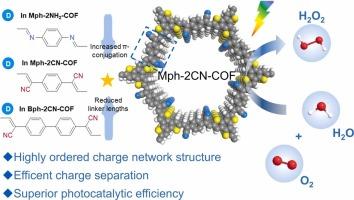Tailoring cyano-functionalized covalent organic frameworks with highly ordered charge network structure for efficient hydrogen peroxide photosynthesis
IF 31.6
1区 材料科学
Q1 MATERIALS SCIENCE, MULTIDISCIPLINARY
引用次数: 0
Abstract
As a vital industrial oxidant, H2O2 suffers from energy-intensive conventional production methods. Covalent organic frameworks (COFs) have emerged as promising photocatalysts for producing H2O2. Conventional imine-linked COFs suffer from inefficient charge separation due to electron localization at nitrogen atoms, which disrupts π-conjugation and promotes charge recombination. To overcome these limitations, we propose cyano-vinylene-linked COFs with precisely designed highly ordered charge networks as an alternative to conventional imine-linked frameworks. The vinyl bridges establish continuous π-conjugation pathways for charge separation, while the cyano groups guide directional electron transfer, collectively forming an efficient charge transport network. Density functional theory (DFT) calculations reveal that synergy between the π-conjugated backbone and cyano groups enhances electron mobility and facilitates electron injection into O2, accelerating *OOH formation and oxygen reduction. Using benzotrithiophene-2,5,8-tricarboxaldehyde (BTT) as a key building block, we synthesized three distinct COF architectures: an imine-linked framework (Mph-2NH2-COF) and two cyano-vinylene-linked variants (Bph-2CN-COF and Mph-2CN-COF). Experimentally, the optimized Mph-2CN-COF achieves a record H2O2 production rate of 9423.2 μmol g−1 h−1 under alkaline conditions, with stable performance over 8 h in a flow reactor, and completes benzylamine coupling in 90 min. These findings demonstrate that constructing highly ordered charge networks is an effective strategy for high-performance photocatalysis, enabling sustainable H2O2 production and organic synthesis.

为高效过氧化氢光合作用定制具有高度有序电荷网络结构的氰化共价有机框架
H2O2作为一种重要的工业氧化剂,传统的生产方法需要耗费大量能源。共价有机框架(COFs)是一种很有前途的光催化剂。由于氮原子上的电子定位破坏了π共轭作用,促进了电荷的复合,使得传统的亚胺连接COFs的电荷分离效率低下。为了克服这些限制,我们提出了具有精确设计的高度有序电荷网络的氰乙烯链COFs,作为传统亚胺链框架的替代方案。乙烯基桥为电荷分离建立了连续的π共轭通道,而氰基引导定向电子转移,共同形成了有效的电荷传输网络。密度泛函理论(DFT)计算表明,π共轭主链和氰基之间的协同作用增强了电子迁移率,促进了电子注入O2,加速了*OOH的形成和氧还原。以苯并三噻吩-2,5,8-三羧醛(BTT)为主要构建块,我们合成了三种不同的COF结构:亚胺连接的框架(Mph-2NH2-COF)和两个氰基乙烯连接的变体(Bph-2CN-COF和Mph-2CN-COF)。实验结果表明,优化后的Mph-2CN-COF在碱性条件下H2O2产率达到9423.2 μmol g−1 h−1,在流动反应器中稳定性能超过8 h,并在90 min内完成苄胺偶联。这些发现表明,构建高度有序的电荷网络是高效光催化的有效策略,可以实现可持续的H2O2生产和有机合成。
本文章由计算机程序翻译,如有差异,请以英文原文为准。
求助全文
约1分钟内获得全文
求助全文
来源期刊

Materials Science and Engineering: R: Reports
工程技术-材料科学:综合
CiteScore
60.50
自引率
0.30%
发文量
19
审稿时长
34 days
期刊介绍:
Materials Science & Engineering R: Reports is a journal that covers a wide range of topics in the field of materials science and engineering. It publishes both experimental and theoretical research papers, providing background information and critical assessments on various topics. The journal aims to publish high-quality and novel research papers and reviews.
The subject areas covered by the journal include Materials Science (General), Electronic Materials, Optical Materials, and Magnetic Materials. In addition to regular issues, the journal also publishes special issues on key themes in the field of materials science, including Energy Materials, Materials for Health, Materials Discovery, Innovation for High Value Manufacturing, and Sustainable Materials development.
 求助内容:
求助内容: 应助结果提醒方式:
应助结果提醒方式:


